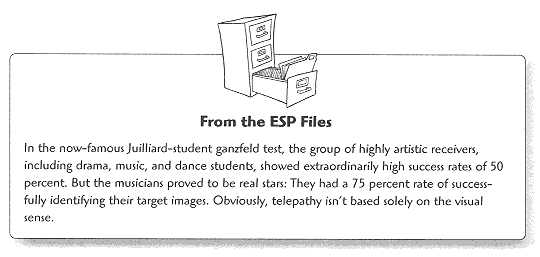|
|
|
|
|
|
|
In the 1980s, researchers revised ganzfeld tests (now called autoganzfield tests) in order to allow computers to control the experiments. Computers randomly select target images, show them to the sender and receiver, and then record the receiver's responses. These computer methods enabled researchers to have less hands-on involvement, which ensured that the transfer of information was not mistakenly occurring through the researchers themselves. Meanwhile, the senders and receivers continued to transfer information at the same rate: about 35 percent (remember that pure chance has a 25 percent hit rate). |
|
|
|
|
|
|
|
|
These new experiments confirmed several earlier findings. For instance, they confirmed previous observations that creative or artistically gifted persons show higher rates of psi ability. A famous experiment, discussed in the Journal of Parapsychology in 1990 by Charles Honorton and his colleagues at the Psychophysical Research Lab in Princeton, New Jersey, tested students from the Juilliard School of Music in New York City as receivers. Their overall hit rate was extremely high: over 50 percent, among the highest ganzfeld hit rates ever recorded. This suggested that creative types are indeed highly intuitiveat least as far as telepathy is concerned. Theories suggest that perhaps such people deal better with information that seems less rational, an ability that may be due in part to their strong right-brain functioning. |
|
|
|
|
|
|
|
|
 |
|
|
|
|
|
|
|
|
Another category of people who tend to score very well on the ganzfeld test are those who have reported previous psi experiences, as well as those who are practiced at meditation or other altered states of consciousness, such as hypnosis. Researchers suggest that these individuals are good at several things that may help promote the telepathic process: relaxation, concentration, and tuning out distractions. |
|
|
|
|
|
|
|
|
One other type of successful ganzfeld receiver has come to the fore: extroverts. These people may show successful results for a variety of reasons. One may be that they crave |
|
|
|
|
|